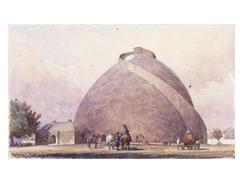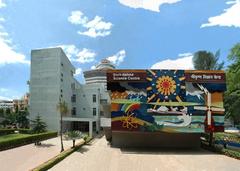
Patna Secretariat Visiting Hours, Tickets, and Historical Significance: A Comprehensive Guide
Date: 04/07/2025
Introduction
The Patna Secretariat, also known as the Old Secretariat or Patna Sachivalaya, stands as both the administrative heart of Bihar and a testament to the state’s colonial-era architectural splendor. Completed in 1917 after the creation of Bihar and Orissa as a separate province, this historic building was designed by British architect Joseph Munnings and constructed by Martin Burn & Co., blending Indo-Saracenic and British colonial styles (patna.nic.in, engr.mun.ca). As the administrative nucleus of Bihar, the Secretariat has played a pivotal role in the governance and history of the state, and its imposing facade, clock tower, and landscaped gardens make it a must-see for architecture enthusiasts, history lovers, and curious travelers alike.
This guide details everything you need to know before visiting the Patna Secretariat, including visiting hours, ticketing, accessibility, notable features, nearby attractions, and practical travel tips. Whether you’re planning a quick stop or a deeper exploration of Patna’s heritage, this resource will help you make the most of your visit.
For the latest information, itinerary planning, and audio guides, visitors are encouraged to use the Audiala app and consult official Bihar tourism portals (patna.nic.in).
Table of Contents
- Colonial Genesis and Historical Context
- Architectural Features and Design Elements
- Political and Administrative Significance
- Cultural and Civic Importance
- Visitor Information: Hours, Tickets, and Accessibility
- On-Site Facilities and Amenities
- Suggested Itineraries and Nearby Attractions
- Practical Tips for Visitors
- Frequently Asked Questions (FAQ)
- Visuals and Media
- Conclusion
- References and Further Reading
Colonial Genesis and Historical Context
Construction of the Patna Secretariat began in 1913, following the administrative separation of Bihar and Orissa from Bengal in 1912, and was finished by 1917. Designed by Joseph Munnings and built by Martin Burn & Co., the Secretariat became the center of state governance, housing the offices of the Chief Minister and senior officials. Its location, flanked by Raj Bhavan and the Patna High Court, established a new administrative core for the capital (patna.nic.in, engr.mun.ca).
The Secretariat has been the backdrop for major events in India’s freedom movement, including the Quit India Movement, commemorated by the nearby Martyrs’ Memorial. Its construction also symbolized the dawn of planned urban development in Patna, with the emergence of broad boulevards and organized neighborhoods.
Architectural Features and Design Elements
The Patna Secretariat exemplifies Indo-Saracenic architectural style, fusing Mughal, Victorian, and classical British elements. The building spans 716 feet in length and 364 feet in width, making it one of the largest government complexes in Patna. Key features include:
- Grand Facades and Arched Entrances: The building’s exterior is adorned with ornate columns, arches, and stonework.
- Clock Tower: Once 198 feet tall (now 184 feet after earthquake damage), the clock tower is a city landmark.
- Wide Verandahs and High Ceilings: Designed to suit Patna’s climate.
- Lush Gardens: Landscaped lawns provide a tranquil environment amid the city bustle.
- Notable Monuments: Statues such as that of Bihar’s first Chief Minister, Srikrishna Sinha, and the Martyrs’ Memorial enrich the historical ambiance.
Political and Administrative Significance
The Secretariat is the administrative nucleus of Bihar, housing the offices of the Chief Minister, Chief Secretary, and key departments. It continues to play a central role in policy-making and state governance, having transitioned from colonial administration to the heart of democratic Bihar (engr.mun.ca). The site has witnessed numerous historic moments, including political rallies and public events.
Cultural and Civic Importance
Beyond administration, the Secretariat is a focal point for civic pride and cultural events. Its proximity to Gandhi Maidan, Kalidas Rangalaya, and Rabindra Parishad makes it a hub for processions, commemorations, and public gatherings. The founding of Patna University in 1917, concurrent with the Secretariat’s establishment, further enhanced the area’s educational and social significance (engr.mun.ca).
Visitor Information: Hours, Tickets, and Accessibility
Visiting Hours
- Weekdays: Open for exterior viewing and garden access from 9:30 am to 6:00 pm, Monday to Friday.
- Weekends/Public Holidays: Generally closed.
- Interior Access: Restricted to government officials and authorized personnel.
Tickets and Guided Tours
- Entry Fee: None. There is no ticket required to view the exterior and gardens.
- Guided Tours: Not regularly available due to security; special arrangements may occasionally be possible during heritage events.
Accessibility
- Grounds: Wheelchair accessible around the exterior.
- Location: Centrally located on Beer Chand Patel Path, between Raj Bhavan and Patna High Court.
- Transport: Easily reached by auto-rickshaw, taxi, cycle-rickshaw, and ride-hailing apps such as Ola and Uber.
- Nearest Railway Station: Sachiwalaya railway station (approx. 0.23 km away).
- Airport: Jay Prakash Narayan International Airport, about 7 km away.
Photography and Security
- Allowed: Exterior and garden areas.
- Restricted: Interior spaces and sensitive zones.
- Tip: Always follow posted signs and security personnel instructions.
On-Site Facilities and Amenities
- Parking: Ample parking for visitors and staff.
- Canteens: Secretariat Sport Club Canteen; nearby options like Bengali Dada Hotel and Singh Meat Hotel.
- Recreation: Green lawns, rose garden, and Kabir Vatika for relaxation.
- Other Facilities: Sub Post Office, badminton hall, and powerlifting training center.
Suggested Itineraries and Nearby Attractions
Half-Day Heritage Walk
- Patna Secretariat: Admire the colonial architecture and gardens.
- Gandhi Maidan: Explore the historic grounds and statues.
- Golghar: Climb for panoramic city views.
- Patna Museum: View ancient artifacts.
- Buddha Smriti Park: Enjoy tranquil gardens and the stupa.
Full-Day Culture & Spirituality Tour
- Morning: Patna Secretariat, Mahavir Mandir.
- Afternoon: Patna Museum, Bihar Museum, lunch at a local restaurant.
- Evening: Takht Sri Harmandir Ji Patna Sahib, stroll at Gandhi Maidan or visit Patna Planetarium.
Other Key Attractions
- Golghar: Iconic granary with panoramic city views (TravelTriangle).
- Patna Museum: Houses over 50,000 artifacts (TravelSetu).
- Bihar Museum: Modern interactive exhibits.
- Buddha Smriti Park: Meditation center and Buddhist relics.
- Mahavir Mandir: Prominent Hindu temple.
- Takht Sri Harmandir Ji Patna Sahib: Revered Sikh gurdwara.
- Patna Planetarium: Astronomy shows for families.
- Kumhrar Park: Pataliputra ruins and Mauryan history.
- Agam Kuan: Ancient well from the Mauryan period (TravelSetu).
- Eco Park, Jalan Museum, Sanjay Gandhi Biological Park: Family-friendly attractions within a 5 km radius.
Day Trips
- Nalanda: UNESCO World Heritage Site (90 km).
- Rajgir: Buddhist, Jain, and Hindu sites (100 km).
- Vaishali: Ancient Buddhist and Jain pilgrimage center (55 km) (TravelSetu).
Practical Tips for Visitors
- Best Time to Visit: October–March for pleasant weather.
- Dress Code: Modest attire appropriate for government and religious sites.
- Essentials: Carry valid photo ID; bring water, sun protection, and umbrellas as needed.
- Accessibility: Contact the Secretariat in advance for assistance if required.
- Safety: Patna is generally safe; exercise standard precautions.
- Cuisine: Try local dishes like Litti Chokha, Khurma, and Thekua at nearby eateries (HIDMC).
- Language: Hindi is widely spoken; English is understood in government and tourist areas.
- Costs: Most sites have nominal or no entry fees; budget for food and transport.
Frequently Asked Questions (FAQ)
Q: What are the visiting hours of Patna Secretariat?
A: Monday to Friday, 9:30 am to 6:00 pm; closed weekends and public holidays.
Q: Is there an entry fee?
A: No, visiting the exterior and gardens is free.
Q: Can I access the interior?
A: Interior access is restricted to authorized personnel.
Q: Are guided tours available?
A: Not regularly; check for special government-organized events.
Q: Is the complex accessible for differently-abled visitors?
A: The exterior and gardens are wheelchair accessible; interior facilities may be limited.
Q: What are the must-visit sites near the Secretariat?
A: Golghar, Patna Museum, Bihar Museum, Gandhi Maidan, Buddha Smriti Park, among others.
Visuals and Media
Enhance your visit by exploring high-resolution images and virtual tours of the Patna Secretariat and nearby attractions on official tourism platforms. Maps and interactive media are available on the Bihar Tourism Department portal for easy navigation.
Conclusion
The Patna Secretariat is more than a functional government building—it is a living symbol of Bihar’s political evolution, colonial heritage, and civic pride. While interior access is limited, its grand exterior, meticulously kept gardens, and surrounding monuments offer a profound narrative of the region’s journey from colonial administration to a modern state. Combine your visit with Patna’s nearby historical and cultural sites for a truly enriching experience.
For real-time updates, itinerary planning, and audio guides, download the Audiala app and follow official Bihar tourism resources. Make the most of your Patna journey by blending heritage, culture, and local experiences.
References and Further Reading
- Patna Secretariat: Visiting Hours, Historical Significance, and Practical Guide for Visitors, 2024, Bihar State Government (patna.nic.in)
- History of Patna from Ancient Time, 2024, Asharan (engr.mun.ca)
- Patna Secretariat: Hours, History, and Nearby Attractions, 2024, Audiala (Audiala app)
- Rough Guides: Patna Travel Guide, 2024 (roughguides.com)
- Things to Do in Patna, 2024, TravelTriangle (traveltriangle.com)
- Patna Tourism History and Guide, 2024, TravelSetu (travelsetu.com)
- Exploring the Ancient City of Patna, HIDMC (HIDMC)





